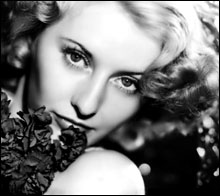Barbara Stanwyck before the Hays Code
By STEVE VINEBERG | April 4, 2006
 The riveting young Barbara Stanwyck who stars in Night Nurse (1931), Baby Face, and Ladies They Talk About (both 1933) — three potboilers the Brattle Theatre has billed over the next week — is an embodiment of that blessedly uncorseted but sadly brief era just before Hollywood was battened down by the self-censoring Hays (Production) Code in 1934. (Baby Face, in a newly restored print that promises to be even sexier than the previously available version, is being shown on its own during the weekend; weeknights it’s double-billed with first Night Nurse and then Ladies.) Stanwyck’s performances in these years, when she became a star, explore the range of female sexual behavior from repressed and unleashed (The Bitter Tea of General Yen) to free-spirited (Ladies of Leisure) to voracious. Baby Face is located at the farthest end of the spectrum: Lily Powers — who escapes a mining town after her saloonkeeper father is killed, heads for Manhattan, and sleeps her way up the secretarial ladder at a bank — is the kind of hard-boiled dame the Hays Code forced filmmakers to vilify (though audiences continued to adore her). In the fascinating Baby Face, she isn’t the femme fatale; she’s the heroine.
The riveting young Barbara Stanwyck who stars in Night Nurse (1931), Baby Face, and Ladies They Talk About (both 1933) — three potboilers the Brattle Theatre has billed over the next week — is an embodiment of that blessedly uncorseted but sadly brief era just before Hollywood was battened down by the self-censoring Hays (Production) Code in 1934. (Baby Face, in a newly restored print that promises to be even sexier than the previously available version, is being shown on its own during the weekend; weeknights it’s double-billed with first Night Nurse and then Ladies.) Stanwyck’s performances in these years, when she became a star, explore the range of female sexual behavior from repressed and unleashed (The Bitter Tea of General Yen) to free-spirited (Ladies of Leisure) to voracious. Baby Face is located at the farthest end of the spectrum: Lily Powers — who escapes a mining town after her saloonkeeper father is killed, heads for Manhattan, and sleeps her way up the secretarial ladder at a bank — is the kind of hard-boiled dame the Hays Code forced filmmakers to vilify (though audiences continued to adore her). In the fascinating Baby Face, she isn’t the femme fatale; she’s the heroine.
Sexually forthright, with the confrontational, squaring-off presence of a tigress alert to intruders and a tender underside that always caught you off guard, Stanwyck wasn’t quite like anything the movies had seen before. That’s because her power was as dependent on what she could do with that gruff, wised-up proletarian alto voice — the way she could use it to tear a line to shreds or veer frighteningly out of control, riding up into hysteria — as on her alert, not-entirely-formed face and her confident physicality. The authority in that voice, as well as its articulation of the wrong-side-of-the-tracks, school-of-hard-knocks background of her characters, was a key element in Hollywood’s movement, in the early-talkie period, toward a grittier realism than the stylization of the silents had allowed. You could say that Stanwyck and the more delicate Sylvia Sidney, who often played slum angels, were the first realist heroines in American movies. And along with Greta Garbo, who’d already developed her style in late silents, Stanwyck represented the advance guard of the great, complex ’30s actresses; Katharine Hepburn, Bette Davis, and Margaret Sullavan followed in her wake. She was stage-trained, though so instinctively camera-savvy and so economical of gesture that you wouldn’t have guessed it unless you thought about the way she handled big emotional scenes, precisely yet expansively.
 Topics
Topics:
Features
, Entertainment, Movies, John Wayne, More  , Entertainment, Movies, John Wayne, William Wellman, George Brent, Sylvia Sidney, Barbara Stanwyck, Greta Garbo, Clark Gable, Less
, Entertainment, Movies, John Wayne, William Wellman, George Brent, Sylvia Sidney, Barbara Stanwyck, Greta Garbo, Clark Gable, Less 